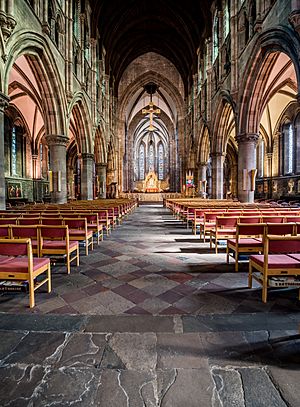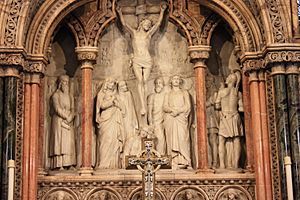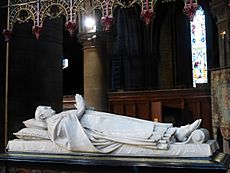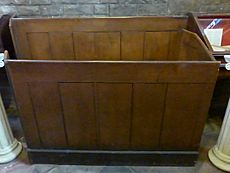St Mary's Cathedral, Edinburgh (Episcopal) facts for kids
Quick facts for kids Saint Mary's Cathedral |
|
|---|---|
| Cathedral Church of Saint Mary the Virgin | |
|
Cathair-eaglais Naomh Moire
|
|
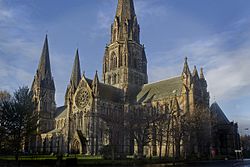 |
|
| Lua error in Module:Location_map at line 420: attempt to index field 'wikibase' (a nil value). | |
| Location | Edinburgh |
| Country | Scotland |
| Denomination | Scottish Episcopal Church |
| Churchmanship | Broad Church |
| History | |
| Dedication | St Mary the Virgin |
| Administration | |
| Diocese | Edinburgh |
St Mary's Cathedral (in Scottish Gaelic: Cathair-eaglais Naomh Moire) is a beautiful church in Edinburgh, Scotland. It is also known as the Cathedral Church of Saint Mary the Virgin. This important building belongs to the Scottish Episcopal Church.
The cathedral was built in the late 1800s. You can find it in the West End of Edinburgh's New Town. It is the main church for the Bishop of Edinburgh. This bishop is one of seven leaders in the Episcopal Church, which is part of the worldwide Anglican Communion.
The famous architect Sir George Gilbert Scott designed the cathedral. It has a Gothic style, which means it looks like old castles and churches. Today, it is a protected building because of its history and beauty. The cathedral's tall spire reaches 90 meters (295 feet). This makes it the highest building in Edinburgh's city area.
Contents
History of the Cathedral
After a big change in Scotland in 1689, the main church became Presbyterian. This meant that the Episcopal church members in Edinburgh no longer had their own main church, or cathedral. For a long time, they met in smaller churches. One of these was an old wool mill! Later, the Church of St Paul in York Place served as their main church until a new cathedral could be built.
How the Cathedral Was Funded
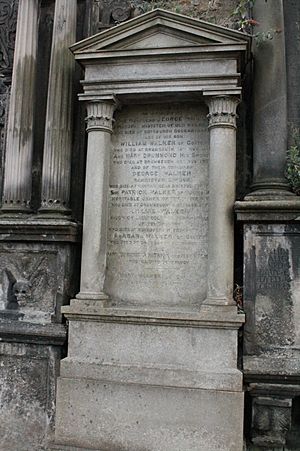
The money to build St Mary's Cathedral came from two sisters, Barbara and Mary Walker. They were unmarried and very generous. They gave funds for the cathedral starting in 1873. The cathedral was even built on land that used to be their garden.
The Walker sisters owned a large area of land nearby called the Drumsheugh Estate. They lived in a house called Easter Coates House, which is still there today. Their family had a long history in Edinburgh. Their father, William Walker, was a lawyer. William Street, a street nearby, is named after him. Their mother was Mary Drummond, whose father, George Drummond, was the mayor of Edinburgh six times! He helped start the New Town.
Building the Cathedral
Sir George Gilbert Scott designed the cathedral. The first stone was laid on May 21, 1874. A special bottle was placed inside this stone. It held important papers, a phone book, newspapers, and coins from that time.
Before the main cathedral opened, a temporary church was set up. It was made of iron! People started worshipping there in 1876. The main part of the cathedral, called the nave, opened on January 25, 1879. Since that day, church services have been held there every day.
The two tall spires at the west end of the cathedral were built later. They are named "Barbara" and "Mary" after the Walker sisters. Building them started in 1913 and finished in 1917. Sir George's grandson, Charles Marriott Oldrid Scott, was the architect for these spires.
Music at St Mary's
St Mary's Cathedral is special because it is the only cathedral in Scotland with daily choir services. The singers, called choristers, come from its own choir school. In 1978, it was the first cathedral in Britain to have girls singing in the choir, not just boys! In 2005, it was also the first Anglican cathedral to have a female alto singer in daily services.
The cathedral has a large organ built in 1879 by Father Henry Willis.
St Mary's Music School was first created to teach the choirboys. Now, it is a separate music school for all students who love music.
The central tower of the cathedral has ten original bells. Two more bells have been added recently. The first Dean of St Mary's, James F. Montgomery, gave these bells as a gift. They were made by John Taylor & Co. in Loughborough. The bells were officially dedicated on October 29, 1879.
The cathedral also hosts many classical music concerts. These happen during the yearly Edinburgh Festival Fringe.
Cathedral Organists
- 1878 Thomas Henry Collinson
- 1929 Robert Head
- 1958 Eric Parsons
- 1961 Dennis Townhill
- 1991 Timothy Byram-Wigfield
- 1999 Matthew Owens
- 2005 Simon Nieminski
- 2007 Duncan Ferguson
Provosts of the Cathedral
The Provost is the main priest of the cathedral.
- 1879–1897 James Montgomery
- 1897–1919 John Wilson
- 1920–1925 Edward Henderson
- 1925–1938 William Margetson
- 1938–1939 Logie Danson
- 1940–1944 David Dunlop
- 1944–1949 Ivor Ramsay
- 1949–1956 Hector Gooderham
- 1957–1967 Reginald Foskett
- 1967–1970 Patrick Rodger
- 1970–1990 Philip Crosfield
- 1990–2017 Graham Forbes
- September 2017– John Conway
Memorials and Special Items
Inside the cathedral, you can find memorials to different people.
- Captain James Dundas V.C. (1842–1879)
- General Sir Alexander Frank Philip Christison Bt. (1893–1993), put up by the Burma Star Association
- Soldiers of the Royal Scots who died overseas from 1857–1870
- A beautiful marble statue of James Francis Montgomery (1902) by James Pittendrigh Macgillivray.
- Barbara and Mary Walker, the sisters who gave money for the church.
The war memorial was created by Pilkington Jackson in 1920.
Special Artefacts
A special church bench, or pew, that belonged to the famous writer Sir Walter Scott was moved to the Cathedral in 2006. It had been in other churches before finding its home here.
Location of the Cathedral
The Cathedral is located between Palmerston Place and Manor Place. This area is in the West End of Edinburgh's New Town. If you are using the Edinburgh Trams, the closest stops are "West End - Princes Street" and "Haymarket".
See also
 In Spanish: Catedral de Santa María de Edimburgo para niños
In Spanish: Catedral de Santa María de Edimburgo para niños


